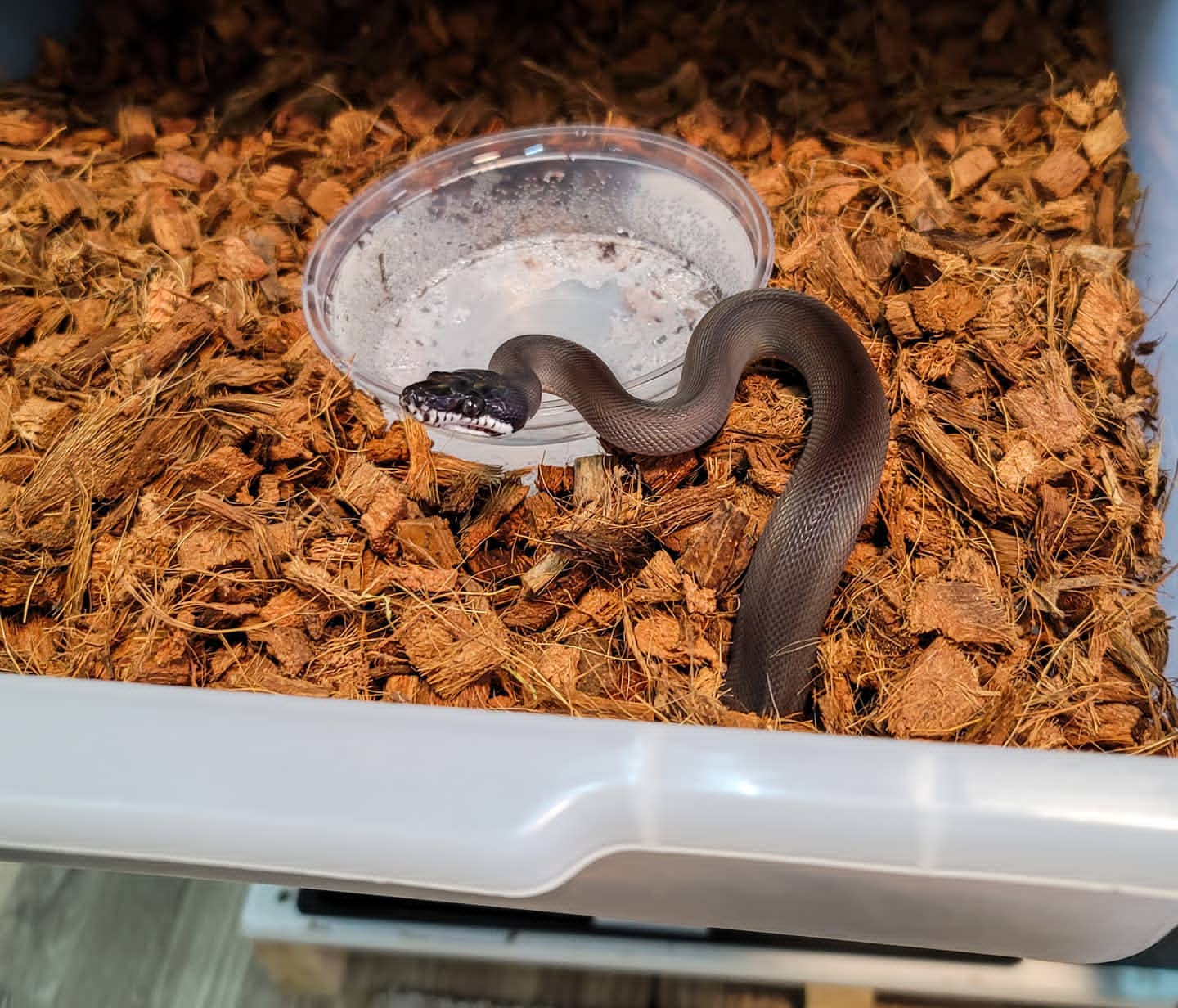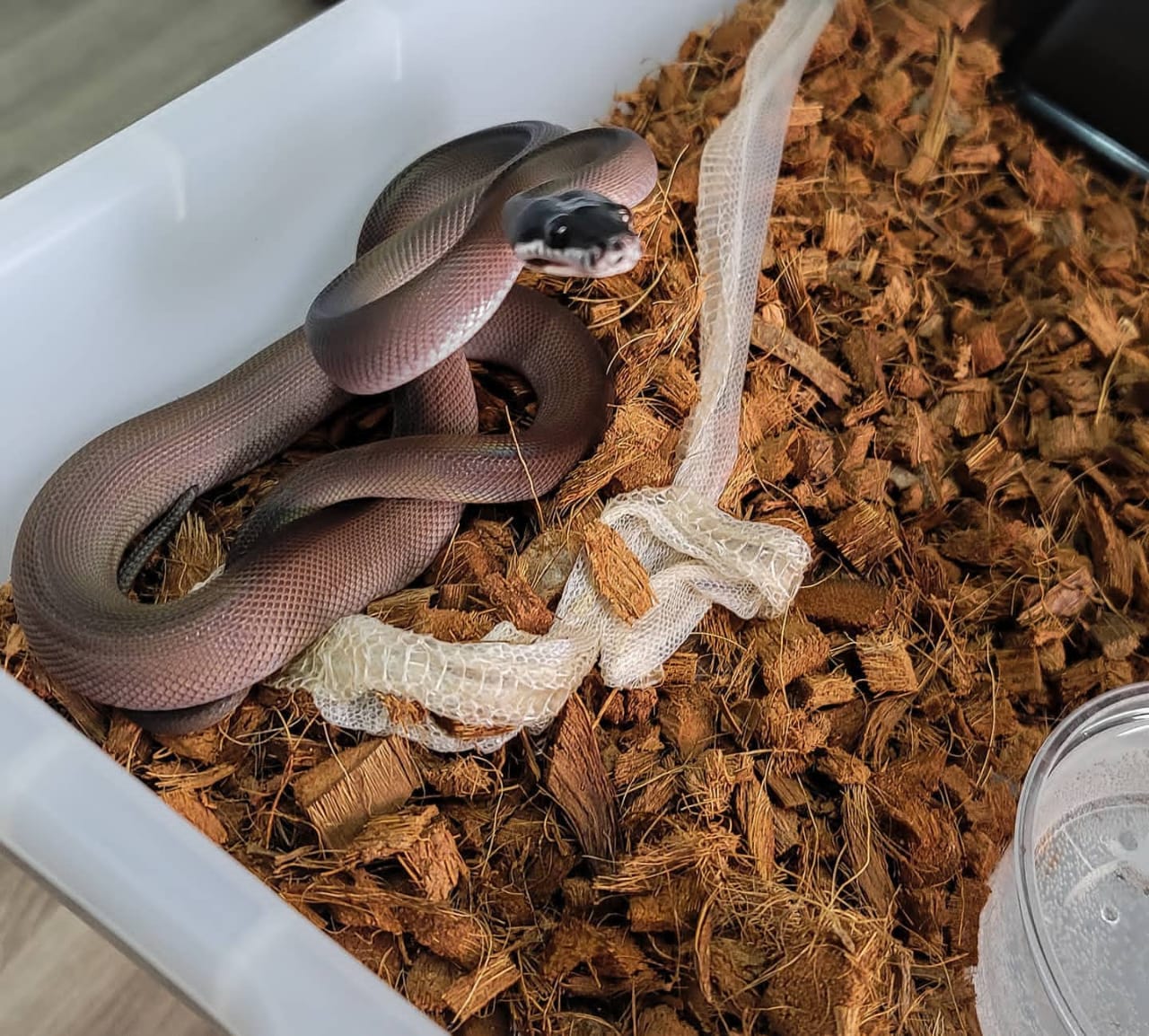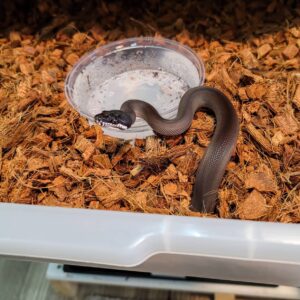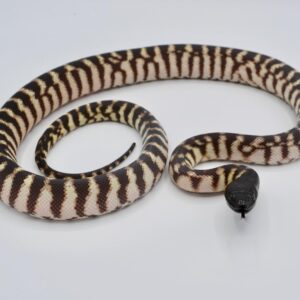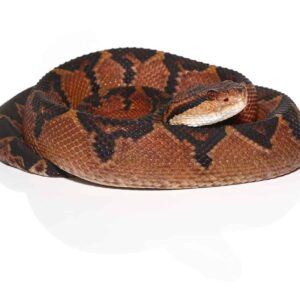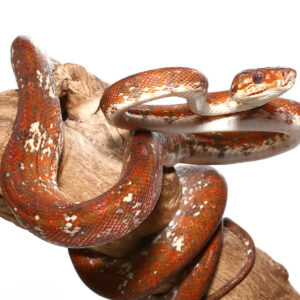Southern White Lipped Python For Sale
$1,150.00
The Southern White Lipped Python (Leiopython albertisii) is a native of the dense, lush forests of Papua New Guinea. The natural habitat that is home to the white-lipped python is comprised of trees, logs, along with leaf litter as well as streams and rivers which provide drinking water sources.
White lipped pythons are terrestrial species, which means that they live upon the floor. However white lipped pythons have been often seen climbing fallen trees and logs. They are crepuscular snakes. White lipped pythons tend to be active in the afternoons and evening.
A widespread species that is found in its natural surroundings, white-lipped pythons are often captured in the wild, or kept in snake farms prior to being brought into the U.S.
Appearance and behavior
The white-lipped python is known for an intimidating look, with an eerie jet-black head and white markings on its mouth that resemble skull teeth. There are two shades of the white-lipped python.
- The northern white lipped Python has an emerald-bronze body and gold-bronze some olive.
- The Southern White Lipped Python is dark brown/black with scales with a purple hue.
In good lighting conditions the scales of the white-lipped snake take on a soap-bubble shimmering shine. The scales of the snake have nanostructures which reflect light, creating the appearance of a multi-colored shine.
Female white lipped Pythons grow larger than males.
Size and Lifespan
White lip pythons are medium snakes which grow to between 72 and 80 inches. Wild, certain females can grow to the size of 84 inches.
The life expectancy of a white-lipped python has been 30 to 40 years. If it is treated properly the snake may last longer than that.
Temperament
White-lipped Pythons are known for their aggression however, they can be better controlled when they are raised in captive.
As nippy snakes black-lipped pythons are a bit more delicate and careful handling. A bite from a white lipped python isn’t poisonous, however getting bitten by an adult snake can be painful.
White-lipped pythons must be kept in a separate area as they can be territorial and required to have their space. The cold temperatures and the wet substrate could stress the white lipped snake and create illness.
Housing White Lipped Pythons
The wild white lipped Pythons live in be found in peaty, green environments, with nearby water sources as well as fallen trees and leaves. Recreate the python’s natural habitat in captivity, by decorating your tank using logs rocks, leaves and a sandy substrate.
Place your white-lipped Python in a terrarium made of PVC or plastic. They are simple to clean and keep humidity well. Avoid using a glass enclosure since glass isn’t able to retain humidity well.
Size of the Southern White Lipped Python enclosure
The minimum size of enclosure for a Southern White Lipped Python measures 48x36x24 in. Because they are medium snakes and spend their majority of times on their feet, white-lipped Pythons require enclosures that is bigger than its height.
Lighting
The best choice of lighting for a Southern White Lipped Python enclosure would be an incandescent bulb such as an Halogen light bulb. This kind of light matches the natural sunlight the white-lipped python see outdoors.
Use only incandescent lights in the daylight hours. Set a timer that allows up to 12 hours of illumination per 24-hour time frame.
Southern White Lipped Python don’t require special UV lighting. Do not expose the tank to sunlight since this can result in the aquarium overheating, which could kill the snake.
Temperature and Humidity
White-lipped pythons are involved in thermoregulation, an activity in which the python locates a location that has the right temperature and humidity based on its metabolic requirements. In order to allow for the regulation of temperature the enclosure must have an area of thermal gradient, or a warm zone and another cooler one, that the snake can choose between.
The tank’s two-thirds area should be at a temperature of 80-85degF. A third of the tank’s surface, called the basking zone, must be at a temperature of 90 degrees. Utilize a heat pad or a heating bulb to raise the temperature of the area of basking.
Hence,
Utilize a thermometer to ensure that the temperatures are stable.
Ideal humidity levels for a Southern White Lipped Python tank is 60% to 80 percent, which is similar to the python’s swamp-like, humid natural habitat. To ensure humidity, choose the substrate that can hold on to the moisture in the air and then place a bowl of water under the source of heat and let the water evaporate and increase the humidity.
White-lipped pythons shed skin about three or four times each year. A high humidity level within the enclosure allows the snake to shed its skin at once.
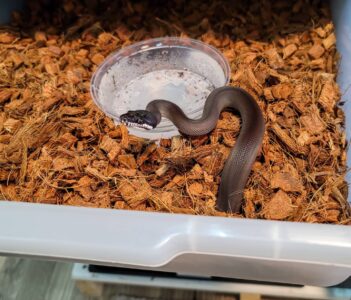
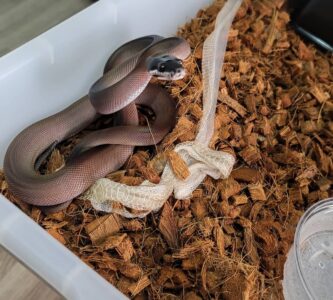
Description
The Southern White Lipped Python, scientifically known as Leiopython hoserae, is a captivating species native to the lush rainforests of Papua New Guinea. Renowned for its distinctive appearance and intriguing behaviors, this reptile has garnered significant interest among herpetologists and reptile enthusiasts alike. The species is named for the conspicuous white scales that adorn its upper lip, providing a stark contrast to its otherwise dark, iridescent body.
In the dense, humid forests of Papua New Guinea, the Southern White Lipped Python thrives in an environment rich in biodiversity. These pythons are primarily found in lowland and mid-montane rainforests, where they utilize the dense foliage and complex terrain to their advantage. Their arboreal tendencies allow them to navigate the forest canopy with ease, although they are equally adept at traversing the forest floor in search of prey.
This species exhibits a remarkable array of physical characteristics that set it apart from other pythons. Its scales shimmer with an iridescent sheen, reflecting hues of green, blue, and gold, particularly when exposed to sunlight. This unique coloration, combined with the white markings on its lips, makes the Southern White Lipped Python a visually stunning reptile. Furthermore, they possess a robust build, with adults typically reaching lengths of 5 to 7 feet, though some individuals may grow even larger.
Understanding the habitat and physical traits of Leiopython hoserae is crucial for appreciating the ecological niche it occupies. As we delve deeper into the specifics of this species, we will uncover more about its behavior, diet, and role within its ecosystem, providing a comprehensive picture of one of nature’s most fascinating serpents.
Physical Characteristics
The Southern White Lipped Python, scientifically known as Leiopython albertisii, stands out in the reptilian world due to its striking physical features. This species typically reaches lengths of 5 to 7 feet, although some individuals can grow up to 9 feet, making it a moderately large python. Its body is robust and muscular, adapted for both climbing and ground hunting.
One of the most distinguishing characteristics of the Southern White Lipped Python is its iridescent skin. The scales exhibit a remarkable sheen, displaying a spectrum of colors under various lighting conditions, which is a trait not commonly seen in other python species. The base coloration ranges from a dark, glossy black to a rich, chocolate brown, often with a purplish hue, enhancing its visual appeal.
The white scales around its lips are perhaps the most iconic feature of this species, giving it its common name. These scales form a distinctive white line that contrasts sharply with the darker body, making it easily identifiable. This unique lip coloration is not just a superficial trait but a significant identifier that sets it apart from other pythons.
When compared to other python species, such as the Ball Python or the Reticulated Python, the Southern White Lipped Python’s iridescence and lip markings are unparalleled. While Ball Pythons are known for their variety of morphs and patterns, they lack the consistent sheen and distinctive lip coloration. The Reticulated Python, on the other hand, is renowned for its intricate patterns and size but does not exhibit the same level of iridescence and lip contrast.
These physical attributes not only make the Southern White Lipped Python a marvel to observe but also contribute to its unique identity among reptile enthusiasts and researchers. Its combination of size, coloration, and distinctive white lips truly sets it apart in the diverse world of pythons.
Habitat and Range
The Southern White Lipped Python (Leiopython albertisii) is predominantly native to the diverse and ecologically rich regions of Papua New Guinea. This reptilian marvel is primarily found in the lowland rainforests and coastal areas, which offer an ideal environment for its survival and proliferation. These habitats are characterized by high humidity, dense vegetation, and a consistent warm climate, all of which are crucial for the python’s thermoregulation and overall well-being.
In the lowland rainforests, the Southern White Lipped Python thrives amidst the thick canopy and plentiful underbrush. The lush vegetation provides ample cover and hunting grounds, where the python can ambush prey such as small mammals, birds, and occasionally reptiles. The forest floor, with its leaf litter and fallen logs, offers not only concealment but also a rich supply of prey, supporting the python’s carnivorous diet. The humidity levels in these regions are essential for the python’s skin health and shedding process, ensuring they maintain their striking iridescent scales.
Coastal areas are another vital habitat for the Southern White Lipped Python. These regions, often marked by mangrove forests and swampy landscapes, provide a different yet equally supportive environment. The python benefits from the abundance of prey species that inhabit these coastal ecosystems. Additionally, the proximity to water sources aids in hydration and facilitates the python’s ability to regulate its body temperature efficiently. The adaptability of the Southern White Lipped Python to both rainforest and coastal settings underscores its resilience and evolutionary success in these biodiverse regions.
The specific regions in Papua New Guinea where the Southern White Lipped Python is commonly found include the southern and eastern parts of the island, where the environmental conditions align perfectly with the species’ needs. The python’s distribution is closely linked to these habitats, as they provide the necessary resources and conditions for feeding, reproduction, and shelter.
Diet and Hunting Behavior
The Southern White Lipped Python (Leiopython albertisii) exhibits a fascinating array of dietary habits and hunting behaviors, making it a remarkable subject of study within the reptilian world. Primarily, this species is carnivorous, favoring a diet that includes small mammals, birds, and occasionally reptiles. Their prey selection showcases their adaptability and skill in various environments, from dense forests to open grasslands.
In their natural habitat, Southern White Lipped Pythons employ ambush tactics to capture their prey. They are known for their patience, often lying in wait for hours until an unsuspecting animal ventures within striking distance. Utilizing their cryptic coloration, they blend seamlessly into their surroundings, making them nearly invisible to both prey and potential predators. Once the prey is within range, the python strikes with remarkable speed, securing its target with powerful jaws and coiling its muscular body around the prey to subdue it through constriction.
One unique aspect of the Southern White Lipped Python’s feeding behavior is its ability to detect and respond to heat signatures. Equipped with specialized heat-sensing pits located along their upper lip, these pythons can sense the body heat of warm-blooded animals, even in complete darkness. This adaptation allows them to hunt effectively at night, broadening their feeding opportunities and giving them an edge over other predators.
After capturing their prey, Southern White Lipped Pythons exhibit a meticulous approach to consumption. They begin by locating the head of the prey and align their jaws to ensure a smooth swallowing process. This species possesses highly flexible jawbones and elastic skin, enabling them to engulf prey items significantly larger than their head. Digestion is another critical phase, facilitated by strong stomach acids that break down the prey efficiently, providing the python with essential nutrients for survival and growth.
The dietary habits and hunting strategies of the Southern White Lipped Python not only highlight its predatory prowess but also underscore its role in the ecosystem as a crucial controller of prey populations. Understanding these behaviors offers valuable insights into the ecological balance within their natural habitats and the adaptive traits that have evolved in this captivating species.
Reproduction and Life Cycle
The reproductive process of the Southern White Lipped Python is a fascinating aspect of its biology. These pythons typically engage in mating rituals during the dry season, which spans from May to October. Males often compete for the attention of females through physical displays and combat. Once a male successfully courts a female, copulation occurs, and the female undergoes a gestation period that lasts approximately three to four months.
During this gestation period, the female Southern White Lipped Python will carefully select a secure and warm location to lay her eggs. The clutch size can range from 10 to 25 eggs, depending on the size and health of the female. Unlike some other reptiles, the Southern White Lipped Python exhibits maternal care by coiling around her eggs to provide protection and regulate their temperature. This behavior ensures the optimum environment for the development of the embryos.
The incubation period for the eggs is typically around 60 to 65 days. As the eggs approach hatching, the young pythons use a specialized egg tooth to break through the shells. Once hatched, the neonates measure approximately 12 to 18 inches in length. These hatchlings are fully independent from birth, possessing the necessary instincts to hunt and fend for themselves.
The early life stages of the Southern White Lipped Python are marked by rapid growth. They feed primarily on small mammals and birds, gradually increasing their prey size as they grow. Juvenile pythons experience frequent molting, shedding their skin to accommodate their expanding bodies. This growth phase continues until they reach sexual maturity, which occurs around 3 to 4 years of age.
As adults, Southern White Lipped Pythons can achieve lengths of up to 8 feet, with some exceptional individuals reaching even greater sizes. Their lifespan in the wild can span up to 20 years, though they may live longer in captivity under optimal conditions. The reproductive and life cycle of the Southern White Lipped Python underscores the adaptability and resilience of this unique reptilian marvel.
Behavior and Temperament
The Southern White Lipped Python exhibits a fascinating array of behavioral traits and temperamental characteristics, making it a subject of interest for herpetologists and reptile enthusiasts alike. This species is primarily nocturnal, engaging in most of its activity during the cooler hours of the night. This nocturnal tendency allows it to hunt and navigate its environment with heightened efficiency while avoiding the intense heat of its native regions.
In terms of interaction with its environment, the Southern White Lipped Python is known for its adeptness at both terrestrial and arboreal navigation. It can often be found slithering gracefully through forest floors or climbing trees and shrubs in search of prey or suitable resting spots. This dual habitat preference underscores the python’s adaptability and resilience in diverse ecological settings.
When it comes to its general demeanor, the Southern White Lipped Python can display a range of temperaments. In the wild, these pythons are typically cautious and reserved, often opting to retreat when faced with potential threats. However, they can exhibit defensive behaviors such as hissing or striking if they feel cornered or provoked. Despite these occasional defensive displays, they are not inherently aggressive.
In captivity, the temperament of the Southern White Lipped Python can vary significantly depending on individual disposition and the level of human interaction it receives. With regular handling and a stress-free environment, they can become relatively docile and tolerant of human presence. However, each python’s temperament is unique, and handlers should always approach them with respect and caution.
Overall, the Southern White Lipped Python’s behavior and temperament are shaped by its nocturnal lifestyle, environmental interactions, and individual disposition. These factors collectively contribute to its reputation as a unique and intriguing reptilian marvel.
Conservation Status and Threats
The Southern White Lipped Python, known for its striking appearance and unique ecological role, currently faces a variety of challenges in its native habitat. The International Union for Conservation of Nature (IUCN) has categorized the species as one of “Least Concern.” However, this classification does not imply that the species is free from threats. Habitat destruction, primarily due to agricultural expansion and deforestation, poses a significant risk. As their natural environment is fragmented and reduced, the Southern White Lipped Python struggles to find adequate resources and safe breeding grounds.
Poaching is another critical threat to these reptiles. The exotic pet trade has led to an increased demand for unique and visually appealing species, making the Southern White-Lipped Python a target for illegal capture and sale. This illegal trade disrupts local populations and can lead to a significant decline in their numbers over time. Furthermore, climate change impacts the delicate ecosystems that these pythons inhabit, altering temperature and precipitation patterns, which can affect their survival and reproductive success.
Conservation efforts are essential to mitigate these threats and ensure the survival of the Southern White Lipped Python. Various initiatives focus on preserving their natural habitats through the establishment of protected areas and national parks. Environmental organizations are also working to raise awareness about the impacts of poaching and the illegal pet trade, promoting stricter enforcement of wildlife protection laws. Additionally, research and monitoring programs aim to gather critical data on population dynamics, habitat usage, and other ecological aspects to inform conservation strategies.
Collaborative efforts between governments, non-governmental organizations, and local communities are crucial for the effective conservation of the Southern White Lipped Python. By addressing the threats they face and implementing targeted conservation measures, it is possible to safeguard this unique reptilian marvel for future generations.
Captive Care and Husbandry
The Southern White Lipped Python, with its iridescent scales and striking appearance, has become a sought-after species among reptile enthusiasts. However, their care in captivity requires a detailed understanding of their specific needs to ensure their well-being and longevity. This section provides a comprehensive guide on the best practices for maintaining these captivating reptiles in a home environment.
Enclosure Requirements
To house a Southern White Lipped Python, one must consider the size and setup of the enclosure. These pythons can grow to significant lengths, necessitating a spacious habitat. A minimum enclosure size of 4 feet by 2 feet by 2 feet is recommended for adults, allowing them ample space to move and explore. The enclosure should be secure, with a tightly fitted lid to prevent escape.
Creating a habitat that mimics their natural environment is crucial. This includes maintaining an ambient temperature between 78-85°F and providing a basking spot of around 90°F. Temperature gradients are essential, allowing the python to regulate its body temperature. Humidity levels should be kept between 60-80%, which can be achieved through regular misting and using a substrate that retains moisture, such as cypress mulch or coconut fiber.
Diet
Southern White Lipped Pythons are carnivorous, thriving on a diet of appropriately sized rodents. Feeding them pre-killed or frozen-thawed mice or rats is advisable to reduce the risk of injury from live prey. Juveniles should be fed every 5-7 days, while adults can be fed every 10-14 days. It’s important to monitor their feeding habits and adjust portions to avoid obesity or malnutrition.
Health Care
Regular health checks are vital to ensure the python’s well-being. Look out for signs of respiratory infections, such as wheezing or mucus around the nostrils, and consult a veterinarian experienced with reptiles if any health issues arise. Keeping their enclosure clean and ensuring proper humidity and temperature can prevent many common health problems.
Handling
Handling Southern White Lipped Pythons should be done with care and respect. These pythons can be defensive, especially when young. Gradual, gentle handling can help them become accustomed to human interaction. Always support their body fully and avoid sudden movements to reduce stress. Consistent, calm handling can foster a more docile demeanor over time.
In conclusion, the Southern White Lipped Python can make a fascinating and rewarding pet for those willing to invest in their proper care. By understanding and meeting their unique needs, reptile enthusiasts can enjoy the beauty and personality of these remarkable creatures in captivity.

